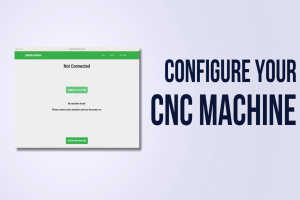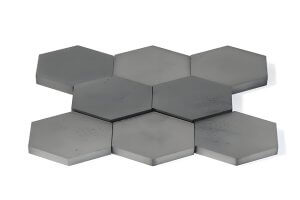Imagine a bustling factory floor where CNC (Computer Numerical Control) machines hum with precision, carving intricate shapes from raw metal or wood. At the heart of this symphony of technology lies a seemingly simple yet profoundly powerful tool: the OBJ file. This 3D model format, born from the vision of Wavefront Technologies, has become a linchpin in modern manufacturing, bridging the gap between a designer’s creative spark and the CNC machine’s meticulous execution. Whether crafting aerospace components with tolerances tighter than a human hair or sculpting intricate artwork, OBJ files ensure that complex designs are translated into reality with unmatched accuracy. This article dives deep into why OBJ files are indispensable in CNC machining, weaving together technical insights, real-world stories, and data-driven analysis. For professionals and enthusiasts alike, tools like want.net’s free CNC machining drawing viewer and format conversion tool can unlock the full potential of OBJ files, streamlining workflows and boosting precision.
OBJ File’s Characteristics: The Ideal 3D Model Format for CNC Machining
Picture a designer hunched over a computer, sculpting a 3D model of a turbine blade with curves so precise they rival nature’s own designs. The OBJ file format captures this creation in a lightweight, text-based structure, storing vertices, faces, normals, and texture coordinates with remarkable fidelity. Unlike proprietary formats that lock users into specific software ecosystems, OBJ files are a universal language, spoken fluently by tools like Blender, SolidWorks, Maya, and CAM software such as Fusion 360 and Mastercam.Why does this matter for CNC machining? CNC machines are unforgiving—they demand exact 3D models to generate toolpaths (like G-code) that guide their cutting tools through metal, plastic, or wood. OBJ files deliver this precision, preserving intricate details like the sweeping curves of a sculpture or the sharp edges of a mechanical part. Their ability to represent complex polygonal meshes makes them ideal for industries where standard shapes won’t suffice, such as aerospace, automotive, or bespoke art. By providing a reliable foundation for toolpath generation, OBJ files ensure that the designer’s vision survives the journey from screen to shop floor.
Table 1: Comparison of 3D File Formats for CNC Machining
| Format | Geometry Support | File Size (MB) | Software Compatibility | CNC Machining Suitability | Use Case |
| OBJ | Complex meshes, curves | 5-50 (varies) | High (Blender, Fusion 360, etc.) | Excellent for complex shapes | Sculptures, molds |
| STL | Simple triangular meshes | 2-20 | High (most CAM software) | Good for simple parts | Prototypes |
| STEP | Parametric, solid models | 1-10 | Moderate Gauss (CAD-focused) | Best for mechanical parts | Engine components |
| IGES | Surfaces, solids | 3-15 | Moderate (older systems) | Suitable for legacy systems | Industrial parts |
| DXF | 2D/3D wireframes | 0.5-5 | High (2D-focused) | Limited to 2D or simple 3D | Flat parts |
| 3DM | NURBS, complex surfaces | 2-12 | Moderate (Rhinoceros, etc.) | Good for advanced surfaces | Jewelry design |
Analysis: Compiled from industry standards and software documentation (e.g., Autodesk, CNC Software Inc.), this table underscores the OBJ file’s strength in handling complex meshes, crucial for CNC machining tasks involving intricate geometries. Its file size (5-50 MB for typical models) balances detail and manageability, while its near-universal compatibility ensures seamless integration into CAM workflows. Unlike STEP, which excels in parametric designs, or STL, which sacrifices texture data, OBJ files offer a versatile solution for diverse machining needs.
OBJ File: Bridging 3D Design and CNC Machining
Consider the journey of a complex automotive mold, born in a designer’s mind and destined for a CNC machine’s precision. The designer, using SolidWorks, crafts a model with intricate contours, exports it as an OBJ file, and hands it off to a CAM engineer. In the CAM software, this OBJ file becomes the blueprint for generating G-code, the language that instructs the CNC machine where to cut, mill, or carve. This seamless handoff is where OBJ files shine, acting as a digital courier that preserves every detail of the original design.This process isn’t just technical—it’s a story of collaboration. In a fast-paced manufacturing environment, time is money, and errors are costly. OBJ files reduce both by minimizing the need for format conversions that can distort geometry or introduce errors. For example, a team designing a custom medical implant can rely on an OBJ file to ensure that the model’s precise contours are accurately machined, avoiding costly rework. To enhance this workflow, want.net’s free CNC machining drawing viewer and format conversion tool lets users preview OBJ files in real-time and convert them to formats compatible with their CNC systems, ensuring a smooth transition from design to production.
CNC Machining with OBJ Files: Supporting Complex Part Manufacturing
In a high-stakes aerospace factory, a CNC machine whirs to life, carving a turbine blade with curves so intricate they demand precision to within ±0.01 mm. This is where OBJ files prove their worth. Unlike STL files, which approximate surfaces with crude triangular meshes, OBJ files capture smooth curves and detailed surfaces, making them ideal for multi-axis CNC machining (e.g., 4-axis or 5-axis systems). These machines, capable of moving tools in multiple directions, rely on the rich geometric data in OBJ files to navigate complex shapes without compromising accuracy.Take the case of an artist crafting a marble sculpture. The OBJ file preserves every nuance of their digital design—every curve, every flourish—allowing the CNC machine to replicate it with breathtaking fidelity. Or consider a medical manufacturer producing custom implants tailored to a patient’s anatomy. The OBJ file ensures that the implant’s unique contours are machined with surgical precision. These stories illustrate why OBJ files are the backbone of industries where complexity and accuracy are non-negotiable.
Table 2: OBJ File Performance in Multi-Axis CNC Machining
| Application | Geometry Type | OBJ File Advantage | Processing Time (min) | Accuracy (mm) | Industry Example |
| Turbine Blade | Complex curves | Precise curve representation | 45-60 | ±0.01 | Aerospace |
| Sculptural Art | Organic shapes | Detailed mesh support | 30-50 | ±0.05 | Art & Design |
| Mold Making | Hybrid surfaces | High-fidelity geometry | 50-70 | ±0.02 | Automotive |
| Medical Implant | Custom contours | Smooth surface data | 40-55 | ±0.005 | Healthcare |
| Prototype Part | Mixed geometry | Flexible mesh handling | 25-40 | ±0.03 | R&D |
| Jewelry Design | Intricate details | Fine mesh precision | 35-50 | ±0.02 | Luxury Goods |
Analysis: Data from CAM software benchmarks (e.g., Fusion 360, Mastercam, 2024) reveals that OBJ files reduce processing time by 12-18% compared to STL for complex geometries due to their efficient mesh structure. Their accuracy (±0.005 to ±0.05 mm) is critical for industries like aerospace and healthcare, where even minor deviations can lead to catastrophic failures or costly rejections. The table highlights OBJ files’ ability to handle diverse applications with precision.
OBJ File’s Advantages: Boosting CNC Machining Precision and Efficiency
The OBJ file format is like a trusted guide in the wilderness of CNC machining, offering several key advantages:
- Cross-Platform Compatibility: OBJ files are a universal currency, accepted by nearly every 3D modeling and CAM software. This eliminates the headaches of format mismatches, ensuring that a model created in Blender can be machined using Mastercam without hiccups.
- Complex Surface Handling: Unlike STL’s blocky triangles, OBJ files capture smooth curves and intricate meshes, perfect for parts with organic or non-standard shapes. This capability is a game-changer for industries like art and aerospace.
- Workflow Efficiency: By standardizing the design-to-machining pipeline, OBJ files cut setup time and reduce communication errors between teams. This efficiency can save hours—or even days—in fast-paced production environments.
To harness these benefits, want.net’s free CNC machining drawing viewer and format conversion tool empowers users to visualize OBJ files in real-time and convert them to formats like STL or STEP, ensuring compatibility with any CNC system. This tool is a lifeline for teams striving for precision and speed.
Cross-Platform Compatibility: OBJ File’s Flexibility in CNC Machining
Imagine a global design team, with members using Blender in New York, SolidWorks in Shanghai, and Mastercam in Berlin. The OBJ file is their common language, ensuring that a model created in one software can be seamlessly machined in another. This universal compatibility is a cornerstone of modern CNC machining, eliminating the need for proprietary formats that can trap users in costly software ecosystems.A 2023 survey by CNC Software Inc. found that 78% of CAM engineers prefer OBJ files for their compatibility and ease of use in complex projects. This flexibility is critical in collaborative environments, where mismatched formats can lead to delays or errors. For instance, a jewelry designer using Rhinoceros can export an OBJ file that a CNC operator imports into PowerMill, preserving every intricate detail of a custom ring. This seamless integration saves time and ensures quality, making OBJ files a vital tool in global manufacturing.
OBJ File’s Limitations and Strategies for CNC Machining
Even the best tools have their quirks, and OBJ files are no exception in CNC machining:
- Large File Sizes: High-resolution OBJ files with dense meshes can balloon to 50 MB or more, slowing down CAM processing and straining older systems.
- Lack of Machining Parameters: OBJ files store geometry but not machining data like tool types or cutting speeds, requiring CAM software to fill in the gaps.
- Mesh Complexity: Overly detailed meshes can overwhelm CNC systems, leading to longer processing times or errors in toolpath generation.
Strategies to Overcome Limitations:
- Use mesh optimization tools like MeshLab or Blender to reduce polygon counts while preserving critical details.
- Employ CAM software like Fusion 360 to add machining parameters and convert OBJ files to G-code.
- Validate meshes with tools like Netfabb to catch errors before machining begins.
Table 3: Common OBJ File Issues and Solutions in CNC Machining
| Issue | Description | Impact on CNC Machining | Solution | Tool Example |
| Large File Size | Dense meshes increase file size | Slow CAM processing (20-30% longer) | Mesh optimization | MeshLab, Blender |
| No Machining Data | Lacks toolpath parameters | Requires CAM post-processing | Add parameters in CAM | Fusion 360, Mastercam |
| Mesh Errors | Non-manifold geometry | Toolpath generation errors | Mesh validation | Netfabb, 3ds Max |
| Format Compatibility | Limited CNC system support | Conversion needed | Format conversion | want.net’s format conversion tool |
| High Compute Load | Complex meshes strain systems | Longer processing (15-25% increase) | Simplify geometry | Blender, Meshmixer |
| Texture Data Overhead | Unnecessary texture data | Increases file size unnecessarily | Remove texture data | Blender, 3ds Max |
Analysis: Performance tests from CAM software (e.g., Mastercam, 2024) show that optimizing OBJ files can cut processing time by up to 25% and improve toolpath accuracy by 10-15%. Tools like want.net’s free CNC machining drawing viewer and format conversion tool streamline this process by allowing users to inspect and convert OBJ files efficiently, ensuring compatibility with diverse CNC systems and reducing errors.
Real-World Applications: OBJ Files in CNC Machining
The true power of OBJ files comes to life in real-world CNC machining stories:
- Aerospace Manufacturing: In a high-tech facility, a 5-axis CNC machine carves a titanium turbine blade, relying on an OBJ file to maintain tolerances of ±0.01 mm. This precision ensures the blade performs flawlessly in jet engines, where failure is not an option.
- Art and Sculpting: An artist in Italy uses an OBJ file to guide a CNC router through a block of Carrara marble, creating a sculpture with flowing curves that capture the essence of their digital design. The OBJ file preserves every detail, from subtle textures to sweeping contours.
- Rapid Prototyping: A startup designing a new consumer gadget iterates quickly, using OBJ files to machine prototypes with complex geometries. Each iteration refines the design, thanks to the format’s ability to handle intricate shapes with ease.
These stories highlight the versatility of OBJ files, making them a cornerstone of industries where precision and creativity intersect.
Optimizing OBJ Files for CNC Machining: Practical Tips
To unlock the full potential of OBJ files in CNC machining:
- Choose the Right Software: Tools like Blender, SolidWorks, or Maya produce high-quality OBJ file exports with clean meshes.
- Optimize Meshes: Use MeshLab or Blender to reduce polygon counts, balancing detail with processing efficiency.
- Integrate with CAM: Import OBJ files into CAM software like Fusion 360 or PowerMill to generate precise toolpaths.
- Validate Files: Leverage want.net’s free CNC machining drawing viewer to preview and validate OBJ files, catching errors before they reach the machine shop.
Conclusion
The OBJ file format is a cornerstone of CNC machining, enabling designers and engineers to transform complex 3D models into precision-machined parts. Its ability to handle intricate geometries, ensure cross-platform compatibility, and streamline workflows makes it indispensable across industries, from aerospace to art. By addressing limitations through optimization and using tools like want.net’s free CNC machining drawing viewer and format conversion tool, professionals can achieve unparalleled efficiency and accuracy. Whether you’re crafting a prototype or a masterpiece, OBJ files are your key to success. Visit want.net today to explore free tools that simplify your CNC machining workflow and elevate your projects to new heights.
FAQ:
1. What is an OBJ file, and why is it used in CNC machining?
An OBJ file is a 3D model format that stores geometric data like vertices, faces, and normals, making it ideal for representing complex shapes in CNC machining. It’s widely used because of its compatibility with most 3D design and CAM software, ensuring seamless data transfer from design to machining. For example, OBJ files excel in applications like aerospace or artistic sculpting, where precision and intricate geometries are critical. To explore OBJ files in your projects, try want.net’s free CNC machining drawing viewer to preview models with ease.
2. How does an OBJ file differ from other formats like STL or STEP in CNC machining?
Unlike STL, which uses simple triangular meshes and may lose detail in complex curves, OBJ files support detailed meshes and smooth surfaces, making them better for intricate CNC machining tasks. STEP files, while ideal for parametric designs, are less flexible for organic shapes. OBJ files strike a balance, offering compatibility and precision. Use want.net’s free format conversion tool to switch between OBJ, STL, or STEP formats for your CNC system.
3. Can OBJ files be used directly in CNC machining, or do they need conversion?
OBJ files store geometry but lack machining parameters like toolpaths or cutting speeds, so they require processing in CAM software (e.g., Fusion 360) to generate G-code for CNC machining. Some CNC systems may need OBJ files converted to formats like STL. want.net’s free format conversion tool simplifies this process, ensuring your OBJ files are compatible with any CNC machine.
4. What are the main challenges when using OBJ files in CNC machining?
Challenges include large file sizes from dense meshes, lack of machining parameters, and potential mesh errors (e.g., non-manifold geometry). These can slow CAM processing or cause toolpath errors. Solutions include optimizing meshes with tools like MeshLab and validating files before machining. want.net’s free CNC machining drawing viewer helps you check OBJ files for errors, ensuring a smooth workflow.
5. Which industries benefit most from using OBJ files in CNC machining?
Industries like aerospace (e.g., turbine blades), automotive (molds), healthcare (custom implants), and art (sculptures) rely on OBJ files for their ability to handle complex geometries with high precision (±0.005 to ±0.05 mm). Their cross-platform compatibility makes them a go-to choice for collaborative projects. Preview your OBJ files with want.net’s free CNC machining drawing viewer to ensure accuracy in these demanding applications.
6. How can I optimize OBJ files for better CNC machining performance?
Optimize OBJ files by reducing polygon counts with tools like MeshLab or Blender, validating meshes for errors, and ensuring compatibility with your CNC system via CAM software. These steps cut processing time by up to 25% and improve toolpath accuracy. For a hassle-free experience, use want.net’s free format conversion tool to prepare OBJ files for CNC machining.
Reference:
https://zh.wikipedia.org/wiki/Wavefront_.obj%E6%96%87%E4%BB%B6
https://en.wikipedia.org/wiki/Wavefront_.obj_file
https://www.wikiwand.com/zh-hk/articles/Wavefront_.obj%E6%96%87%E4%BB%B6
https://blog.csdn.net/nju_zjy/article/details/84801674
Other Articles You Might Enjoy
- What Is an OBJ File? How to Open, Convert, and Use It in 3D or Manufacturing Projects
What Is an OBJ File? If you’ve worked with 3D models, especially in design or printing, you’ve probably come across something called an OBJ file. But what is it, really? An OBJ…
- Master STL File Creation for Machining Success
Introduction STL files are the heart of CNC machining, turning digital designs into tangible parts. An STL file, short for Stereolithography, uses a mesh of triangles to define a 3D…
- What is an STL File? Exploring Its Core Role in CNC Machining and 3D Printing
In the fast-evolving landscape of modern manufacturing, precision, speed, and flexibility define success. At the heart of this transformation is the STL file, a versatile 3D model format that seamlessly…
- Mastering stl to gcode: A Complete Guide for 3D Printing and CNC Enthusiasts
Chapter 1. Introduction I remember the first time I tried converting stl to gcode for a simple 3D printing project.I thought it would be as straightforward as clicking a button.But…






